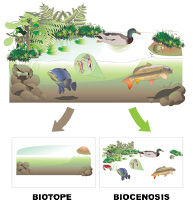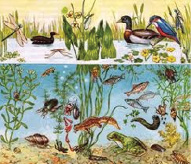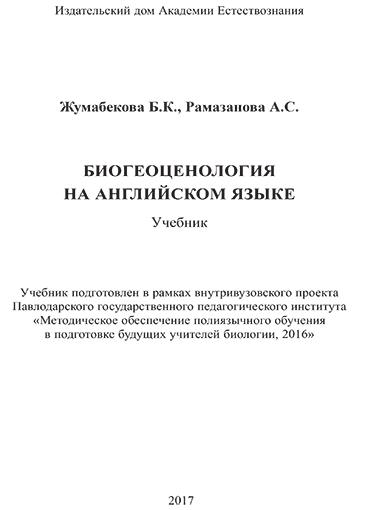
Научная электронная библиотека
Монографии, изданные в издательстве Российской Академии Естествознания
Chapter 7. COMPONENTS OF A BIOCENOSIS
|
Essential targets: By the end of this chapter you should be able to: Distinguish a biocenosis and agrobiocenosis; Distinguish the components of biocenosis; Determinate the producers, consumers, decomposers.. |
Read the text. Write out the key words. Mark the arrows between the interrelated key words. Explain the resulting scheme / Мәтінді оқып шығыңдар. Түйінді сөздерді теріп, жазып алыңдар. өзара байланысты сөздерді бағдаршалармен белгілеңдер. Алынған сызбаны түсіндіріңдер / Прочитайте текст. Выпишите ключевые слова. Отметьте стрелками взаимосвязанные слова. Объясните полученную схему.
Biocenosis is totality of plants, animals, and microorganisms that inhabit a sector of land or a body of water and are characterized by definite relationships both among themselves and with abiotic factors of the environment (Fig. 1). The term “biocenosis” was proposed by the German biologist K. Mobius in 1877. A biocenosis is the complex of organisms of a biogeocenosis which forms as a result of the struggle for existence, natural selection, and other evolutionary factors.

Figure 1. Ecosystem = biotope + biocenosis [2]
Three groups of organisms are distinguished in a biocenosis according to their participation in the biogenic cycle of substances. The first group is the producers – autotrophic organisms – which produce organic substances from inorganic substances; the chief producers in all biocenosis are green plants. The activity of the producers determines the initial stock of organic substances in the biocenosis. The second group is the consumers – heterotrophic organisms – which feed at the expense of the autotrophic organisms. Consumers of the first order are herbivorous animals, as well as parasitic bacteria, fungi, and other achlorophyllous plants that develop at the expense of live plants. Consumers of the second order are predators and parasites of herbivorous organisms. Consumers of the third and fourth orders (hyperparasites, superparasites, and such) exist, but altogether there are no more than five links in food chains. At each successive trophic level the quantity of the biomass decreases sharply. The activity of the consumers makes possible the transformation and transportation of organic substances within the biocenosis, their partial mineralization, and the dispersion of energy accumulated by the producers. The third group is the reducers – animals that feed on the decomposed remains of organisms (saprophages), especially nonparasitic heterotrophic organisms. Reducers make possible the mineralization of organic substances and their conversion to an assimilated state by the producers [1].
The interrelationships of organisms within a biocenosis are diverse. In addition to trophic links, which determine food chains and which are sometimes very unusual (parasitism, symbiosis), there are links based on the fact that some organisms become substrates for others (topical relations), create the necessary microclimate, and so on. It is often possible to trace groups of species in a biocenosis that are connected with a definite species and are completely dependent on it (“consortions”) [2].
The division into smaller subordinate units – merocenosis (that is, naturally composed complexes that are dependent in their entirety on the biocenosis – for example, the complex of inhabitants of rotting oak stumps in an oak forest) – is characteristic for biocenosis. If animals (for example, bats in a cave biocenosis) rather than autotrophs serve as the energy source for a biocenosis, such a biocenosis is dependent on a supply of energy from without and is incomplete – in essence a merocenosis. Other subordinate groupings (for example, synusia) may be distinguished in biocenosis. Vertical grouping of organisms (biocenotic strata) is also characteristic of biocenosis. The number, developmental stages, and activity of certain species change in an annual cycle, and regular seasonal aspects of biocenosis are created (Fig. 2) [1].

Figure 2. Biocenosis [3]
A biocenosis is a dialectically developing whole that changes as a result of the activity of its components; as a consequence of this, regular changes and replacements occur in the biocenosis (succession), which may lead to the reconstitution of severely disrupted biocenosis (for example, forests after a fire). A distinction is made between saturated and unsaturated biocenosis. In a saturated biocenosis, all ecological niches are occupied, and the establishment of a new species is impossible without the destruction or subsequent displacement of some component of the biocenosis. Unsaturated biocenosises are characterized by the possibility of the settlement within them of new species without the destruction of other components. It is possible to distinguish primary biocenosis, which are formed without the influence of man (virgin steppe or forest), and secondary biocenosis, which are changed by the activities of man (forests grown to replace those removed, the populations of water reservoirs). Agrobiocenosis are a special category in which the complexes of basic components are consciously regulated by man. Between the primary biocenosis and the agrobiocenosis there is a complete range of intermediate types. The study of biocenosis is important for the rational management of land and water areas, since only a proper understanding of the regulative processes of biocenosis enables man to withdraw a portion of the production of a biocenosis without disrupting or destroying it [1].
Glossary of essential terms / Негізгі терминдер глоссарийі / Глоссарий основных терминов
|
№ |
English term |
Kazakh equivalent |
Russian equivalent |
|
1 |
annual cycle |
жылдық цикл |
годовой цикл |
|
2 |
bat |
жарқанат |
летучая мышь |
|
3 |
consumer |
пайдаланушы |
потребитель |
|
4 |
destruction |
жоюшылық |
уничтожение |
|
5 |
displacement |
ығыстыру |
вытеснение |
|
6 |
distinguished |
белгілі |
известный |
|
7 |
herbivorous animal |
шөпқоректі жануар |
травоядное животное |
|
8 |
oak |
емен |
дуб |
|
9 |
recovery |
қайта құру |
восстановление |
|
10 |
the dispersion of energy |
құаттың тарауы |
рассеивание энергии |
|
11 |
the initial stock |
бастапқы қоры |
начальный запас |
|
12 |
the struggle for existence |
тіршілік үшін күрес |
борьба за существование |
|
13 |
to break |
бұзу |
нарушать |
|
Key phrases and sentences / Түйінді сөздер мен сөйлемдер / Ключевые фразы и предложения 1. A biocenosis is a part of the … / Биоценоз … бір бөлшегі/ Биоценоз является частью ... 2. The concept of a …was introduced by … in …/ … термині ____________ж. … енгізілді/ Понятие … было введено … в … 3. The components of biocenosis are: …/ Биоценоздың компо-ненттері: …/ Компонентами биоценоза являются ... 4. Phytocenosis (...) is a component of ... / Фитоценоз (...) ... бір компоненті болып табылады/ Фитоценоз (...) является компонентом ... 5. . … (the totality of animals in a biocenosis) is a component of ... / ... (биоценоздағы жануарлардың жиынтығы) … бір компоненті болып табылады/ ... (совокупность животных в биоценозе) является компонентом ... 6. Most producers are ... / Түзушілердің көбісі – .../ Большинство продуцентов – это ... 7. All animals are .../ Жануарлардың барлығы – .../ Все животные – это ... 8. Earthworms, fungi, bacteria, some insects are ... / Жауын құрттар, саңырауқұлақтар, бактериялар, кейбір жәндіктер – .../ Дождевые черви, грибы, бактерии, некоторые насекомые – это ... |
I. Work in groups. Read the given text. Make three cinquains on the topic. Let each group to read their cinquains and choose the most interesting cinquain. Watch video https://www.youtube.com/watch?v=MPZI2M1fDi8. Prepare the answer to the question: What are producers, consumers, decomposers? / Топпен жұмыс. Мәтінді оқып шығыңдар. Тақырып бойынша үш синквейн құрастырыңдар. әрбір топ өз синквейндарын оқып шығып, қызықты деген синквейнді таңдап алыңдар. Бейнежазбаны қарап шығыңдар https://www.youtube.com/watch?v=MPZI2M1fDi8. Продуценттер, консументтер, редуценттер не? деген сұраққа жауап дайындаңдар / Работа в группах. Прочитайте текст. Составьте три синквейна по теме. Дайте каждой группе прочитать их синквейны и выбрать наиболее интересный синквейн. Просмотрите видео https://www.youtube.com/watch?v=MPZI2M1fDi8. Подготовьте ответ на вопрос: Что такое продуценты, консументы, редуценты?
The Circle of Life
Imagine the circle of life that takes place on an African savanna. The grass grows and is eaten by an antelope. The antelope is caught and eaten by a cheetah. The cheetah dies, is eaten by bacteria and nutrients are returned to the soil. These nutrients are used by the grass as it continues to grow on the savannah. Each organism has a purpose. Like this example, there is a simple pattern of energy flow through organisms in any ecosystem. What are other examples you can think of?
There are three main groups to consider when looking at the circle of life in a biocenosis. The groups are producers, consumers, and decomposers. These groups are based on how the organism obtains food. Producers, consumers, and decomposers all interrelate in food chains and food webs and are dependent on one another for survival.
Producers make their own food. They do not have to obtain energy from other organisms. They obtain their energy from the sun and make food with that energy through the process of photosynthesis. Producers may also be called autotrophs. Most producers are plants, but there are some small organisms that produce food through photosynthesis as well. Producers are at the beginning of any simple food chain. On the African savanna, examples of producers would be any of the plants that grow there [4].
Consumers cannot make food. Consumers are animals that must consume something else, either plants or other animals, to get their energy. If consumers only eat plants, they are called herbivores (or primary consumers). If they only eat animals, they are called carnivores (secondary consumers). And if they consume both plants and animals, they are called omnivores. Some examples of consumers include: mice, dogs, fish, humans, bees, hummingbirds, etc.
Decomposers are organisms that break down dead or decaying organisms, and in doing so, they carry out the natural process of decomposition.[1] Like herbivores and predators, decomposers are heterotrophic, meaning that they use organic substrates to get their energy, carbon and nutrients for growth and development [5].
II. Read the given text. Explain why microorganisms are important for the nature and life? Give the examples of application of microorganisms in the human life / Мәтінді оқып шығыңдар. Не себептен микроағзалар табиғат және тіршілік үшін маңызды екенін түсіндіріңдер. Адам өмірінде микроағзаларды пайдалануына қатысты мысал келтіріңдер / Прочитайте текст. Объясните, почему микроорганизмы имеют важное значение для природы и жизни? Приведите примеры применения микроорганизмов в жизни человека.
One of the living components of biogeocenosis is microbiocenosis (microorganisms community). Microorganisms are microscopic, living, single-celled organisms such as bacteria. Ubiquitous throughout the world, microorganisms play a vital role in supporting and maintaining nature and life. The vast majority are beneficial: they keep nature clean by removing toxins from water and soil, and degrade organic matter from dead plants and animals. In the human body they aid in digestion and help prevent invasion by harmful bacteria. Without bacteria, life would not be possible.
III. Answer the questions / Сұрақтарға жауап беріңдер / Ответьте на вопросы:
1. In what ways may saprophytic fungi be (a) useful, (b) harmful?
2. Saprophytic bacteria release ….. A ….. into their surroundings and then absorb the …. B …..
3. Choose the most appropriate word from the list below to complete the following sentence: Aerobic bacteria differ from anaerobic bacteria because they need ….. A ….. for their respiration.
air, oxygen, food, light
4. Give one example in each case of the usefulness of bacteria in (a) a natural environment, (b) an industrial process.
IV. Fill in the table / Кестені толтырыңдар / Заполните таблицу.
Comparative characteristics of the biocenosis and agrocenosis
|
Criterion |
Biocenosis |
Agrocenosis |
|
Components |
||
|
The use of energy |
||
|
The stability of the system |
V. Fill in the table « Layers of a rainforest». Describe the living components of each layer / «Тропикалық орман деңгейлері» кестесін толтырыңдар. Әрбір деңгейдің тірі компоненттерін сипаттаңдар / Заполните таблицу «Уровни тропического леса». Опишите живые компоненты каждого уровня.
|
|
Emergent layer |
|
|
Canopy layer |
|
|
Understory layer |
|
|
Forest floor |
|
SUMMARY A biocenosis (alternatively, biocoenose or biocenose), termed by Karl Möbius in 1877, describes all the interacting organisms living together in a specific habitat (or ecotope). Biotic community, biological community, and ecological community are more common synonyms of biocenosis, all of which represent the same concepts. A biocenosis includes phytocenosis (plan communities), zoocenosis (the totality of animals in a biocenosis) and microbiocenosis (microbial community). Most plans are producers. All animals (herbivores, carnivores, omnivores) are consumers. Decomposers are organisms that break down and eat dead animals and plants. Examples of decomposers include: earthworms, fungi, bacteria, etc. An agrobiocenosis is an association of organisms in the sowings and plantings of cultivated plants; one of the widespread forms of secondary biocenoses. |
 Topics for an essay:
Topics for an essay:
1. The structural-functional organization of the biocenosis and its analysis.
2. The spatial organization of the biocenosis. Parcel definition.
3. The ecological structural formation of biogeocenosis.
4. The concept of consortium in ecology.
5. Animals as components of biocenosis.
6. Ecological groups and vital forms of animals.
7. Plants as components of biocenosis.
8. Ecological groups and vital forms of plants.
9. Fungi and lichens as components of biocenosis.
10. Microorganisms as components of biocenosis.
 References:
References:
1. The free dictionary // http://encyclopedia2.thefreedictionary.com/Biogeocenosis
2. E School Today // http://eschooltoday.com/ecosystems/what-is-an-ecosystem.html
3. Ecology Study Site // http://www.nps.gov/pete/forteachers/images/ecosystem.jpg
4. Study // http://study.com/academy/lesson/producers-consumers-decomposers-in-ecosystems.html




